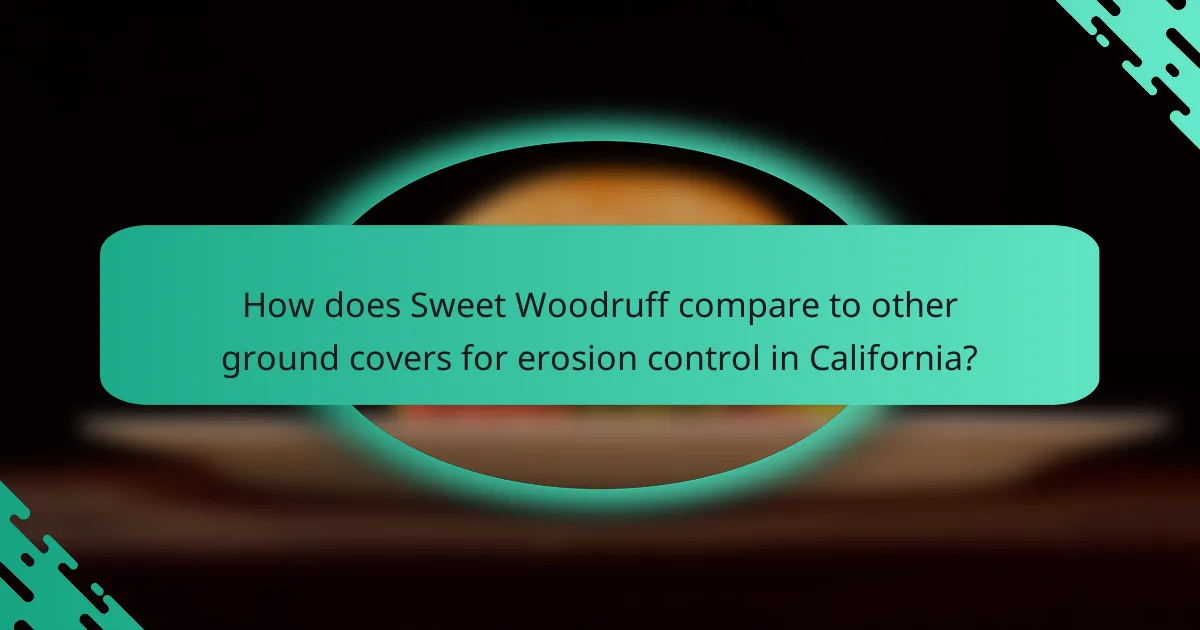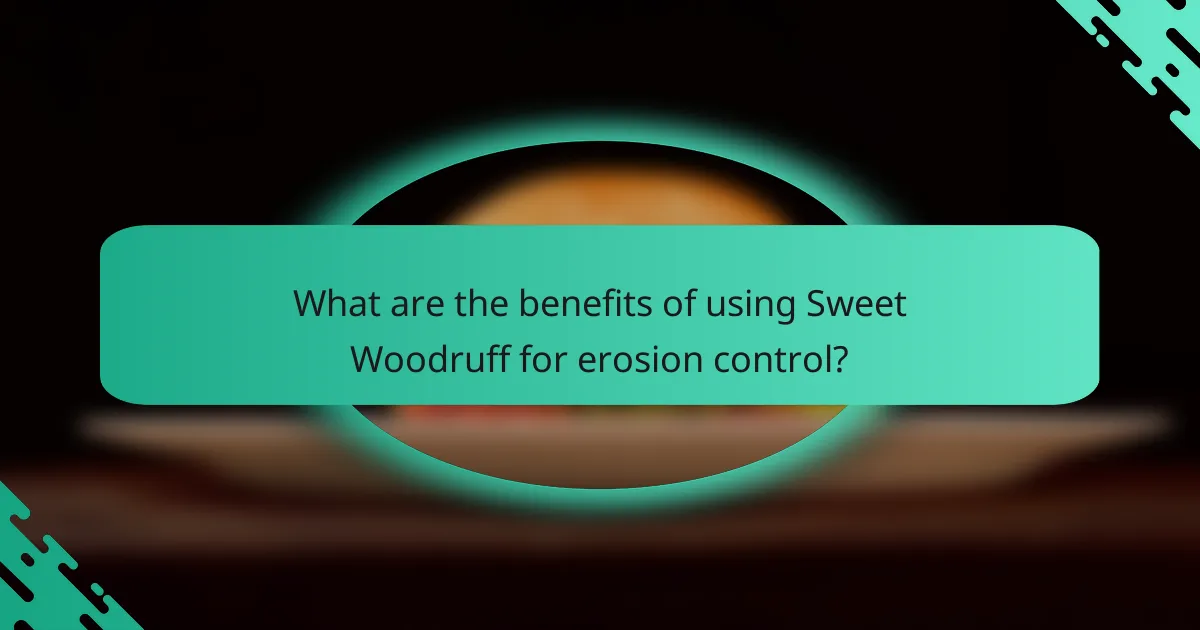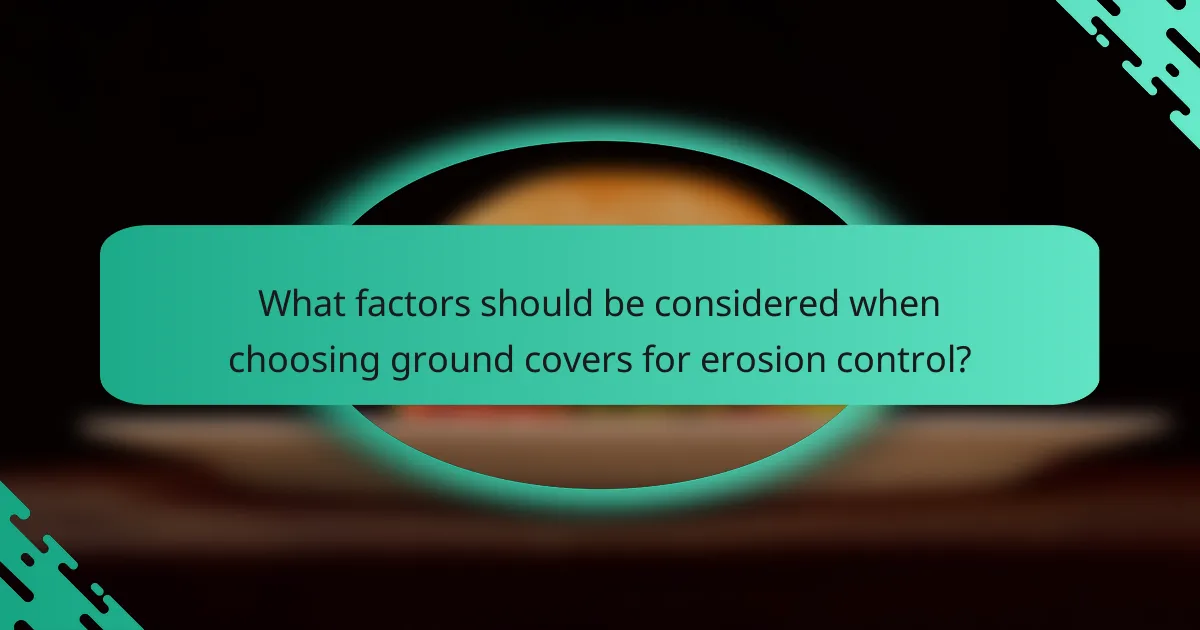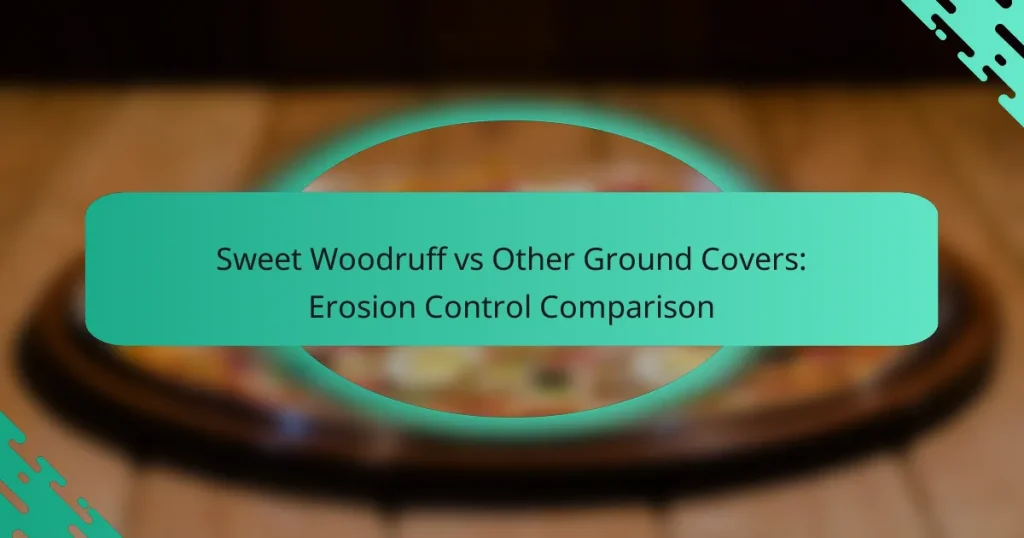Sweet Woodruff is a popular choice for erosion control due to its dense growth and extensive root system, which effectively stabilizes soil and reduces runoff. While it excels in moisture retention and low maintenance, it also has limitations compared to other ground covers, such as specific light and soil requirements. Understanding these factors is essential for selecting the most suitable ground cover for your landscape needs.

How does Sweet Woodruff compare to other ground covers for erosion control in California?
Sweet Woodruff is an effective ground cover for erosion control in California, offering benefits such as moisture retention and low maintenance. Compared to other options, it establishes quickly and provides a dense mat that helps prevent soil erosion.
Effective moisture retention
Sweet Woodruff excels at retaining moisture, making it ideal for California’s dry climate. Its dense foliage creates a microclimate that reduces evaporation, allowing the soil to stay moist longer, which is crucial during hot, dry periods.
This moisture retention not only benefits the Sweet Woodruff itself but also supports surrounding plants, helping to create a more resilient ecosystem. This characteristic is particularly valuable in areas prone to erosion due to dry conditions.
Low maintenance requirements
One of the advantages of Sweet Woodruff is its low maintenance needs. Once established, it requires minimal watering and can thrive in various soil types, making it a practical choice for homeowners and landscapers alike.
Regular trimming may be necessary to keep it tidy, but overall, it does not demand significant time or resources, allowing for a more hands-off approach to garden care.
Rapid growth rate
Sweet Woodruff has a rapid growth rate, which helps it establish quickly and cover bare soil effectively. This fast establishment is crucial for erosion control, as it reduces the time during which soil is exposed to the elements.
In optimal conditions, it can spread significantly within a single growing season, making it a reliable option for immediate erosion control needs.
Comparison with Creeping Thyme
When comparing Sweet Woodruff to Creeping Thyme, both serve as effective ground covers, but they have different moisture needs. Creeping Thyme thrives in well-drained soils and prefers drier conditions, while Sweet Woodruff is better suited for shadier, more moisture-retentive areas.
Additionally, Creeping Thyme can be more drought-tolerant once established, but it may not provide the same level of erosion control in moist environments as Sweet Woodruff does.
Comparison with Irish Moss
Irish Moss is another popular ground cover, but it has different growth habits compared to Sweet Woodruff. While Irish Moss prefers cooler, moist conditions and can tolerate some foot traffic, it may not be as effective in retaining moisture in drier climates like California.
Sweet Woodruff, on the other hand, adapts well to various conditions and offers superior erosion control, especially in shaded areas where moisture retention is critical.

What are the benefits of using Sweet Woodruff for erosion control?
Sweet Woodruff is an effective ground cover for erosion control due to its dense growth habit and extensive root system. It stabilizes soil, reduces runoff, and enhances the overall health of the ecosystem.
Prevention of soil erosion
Sweet Woodruff prevents soil erosion by forming a thick mat of foliage that protects the soil surface from rain impact and wind. Its fibrous roots bind the soil together, making it less susceptible to being washed away during heavy rains.
When planted on slopes or in areas prone to erosion, Sweet Woodruff can significantly reduce soil loss, especially in regions with moderate rainfall. Regular maintenance, such as trimming, can help maintain its density and effectiveness.
Enhancement of soil health
This ground cover contributes to soil health by promoting biodiversity and improving soil structure. As Sweet Woodruff decomposes, it adds organic matter to the soil, enhancing nutrient availability for other plants.
Additionally, it can help suppress weeds, which compete for nutrients and water, further benefiting the soil ecosystem. Incorporating Sweet Woodruff into your landscape can lead to a healthier, more resilient soil environment.
Attractive ground cover
Sweet Woodruff is not only functional but also visually appealing. Its delicate white flowers and lush green foliage create an attractive ground cover that can enhance the aesthetics of any garden or landscape.
It thrives in shaded areas, making it an excellent choice for under trees or in woodland gardens. By using Sweet Woodruff, you can achieve both erosion control and a beautiful landscape without compromising on either aspect.

What are the limitations of Sweet Woodruff compared to other options?
Sweet Woodruff has several limitations when compared to other ground cover options, particularly regarding its growth behavior, light requirements, and soil preferences. While it can be an effective ground cover for certain conditions, its invasive nature and specific growing needs may not make it the best choice for every landscape.
Invasive growth potential
Sweet Woodruff can exhibit invasive growth, spreading rapidly in favorable conditions. This can lead to it outcompeting native plants and other desired species in your garden. If not managed properly, it may require regular maintenance to control its spread.
In contrast, other ground covers such as creeping thyme or clover may offer more controlled growth patterns, making them easier to manage in diverse landscapes. Consider your garden’s ecosystem before choosing a ground cover to avoid potential invasiveness.
Shade tolerance limitations
While Sweet Woodruff thrives in shaded areas, it has limitations in terms of the amount of shade it can tolerate. It generally prefers partial shade and may struggle in deep shade or full sun, which can hinder its growth and effectiveness as a ground cover.
Other ground covers, like ajuga or periwinkle, may provide better options for full shade or sun exposure, offering more versatility in various garden settings. Assess the light conditions in your garden to select the most appropriate ground cover.
Soil type preferences
Sweet Woodruff prefers moist, well-drained soils rich in organic matter. It may not perform well in sandy or overly dry soils, which can limit its effectiveness in certain regions. If your soil conditions do not match these preferences, Sweet Woodruff may struggle to establish itself.
In comparison, ground covers such as sedum or creeping phlox can adapt to a wider range of soil types, including poorer or drier soils. When selecting a ground cover, evaluate your soil type to ensure compatibility with the plant’s needs for optimal growth and erosion control.

What factors should be considered when choosing ground covers for erosion control?
When selecting ground covers for erosion control, consider climate adaptability, soil composition, and sunlight exposure. Each of these factors influences how well a plant can establish itself and prevent soil erosion in a specific environment.
Climate adaptability
Climate adaptability refers to a plant’s ability to thrive in various weather conditions. Ground covers like sweet woodruff are well-suited for temperate climates, while others may perform better in arid or tropical regions. Assessing local climate patterns, including temperature ranges and precipitation levels, is essential for effective erosion control.
For example, if you live in a region with harsh winters, choose ground covers that can withstand freezing temperatures. Conversely, in warmer areas, select plants that can tolerate heat and drought.
Soil composition
Soil composition plays a crucial role in determining which ground covers will succeed in erosion control. Different plants have varying preferences for soil types, such as sandy, clay, or loamy soils. Testing your soil can help identify its pH, nutrient levels, and drainage capabilities, which are vital for plant health.
For instance, sweet woodruff thrives in moist, well-drained soils, making it an excellent choice for shaded areas. In contrast, other ground covers may require more alkaline or nutrient-rich soils to establish effectively.
Sunlight exposure
Sunlight exposure is another critical factor in selecting ground covers for erosion control. Some plants, like sweet woodruff, prefer partial to full shade, while others need full sun to flourish. Understanding the light conditions of your site will help you choose the right species.
Evaluate the sunlight patterns throughout the day in your area. If your site receives limited sunlight, opt for shade-tolerant ground covers. In sunny locations, select plants that can withstand direct sunlight and heat to ensure optimal growth and erosion prevention.

How does Sweet Woodruff perform in different soil types?
Sweet Woodruff thrives best in loamy soils, which provide the ideal balance of moisture retention and drainage. Its performance can vary significantly in sandy and clay soils, influencing its effectiveness as a ground cover for erosion control.
Best performance in loamy soils
Loamy soils, rich in organic matter, offer Sweet Woodruff the nutrients and moisture it needs to flourish. This soil type promotes robust root development, allowing the plant to effectively stabilize soil and prevent erosion. Regular watering and mulching can further enhance its growth in these conditions.
When planted in loamy environments, Sweet Woodruff can spread quickly, creating a dense mat that not only controls erosion but also suppresses weeds. This makes it an excellent choice for gardeners looking to maintain healthy landscapes.
Challenges in sandy soils
Sandy soils present challenges for Sweet Woodruff due to their quick drainage and lower nutrient content. While the plant can survive in these conditions, it may struggle to establish a strong root system, leading to less effective erosion control. Regular watering is essential to help maintain moisture levels.
To improve its chances in sandy soils, consider amending the soil with organic matter or using mulch to retain moisture. However, be prepared for slower growth and potentially less coverage compared to loamy soils.
Adaptability to clay soils
Sweet Woodruff can adapt to clay soils, but its performance may be hindered by poor drainage and compacted conditions. While it can survive, the risk of root rot increases if the soil remains too wet. It is crucial to ensure proper drainage to support healthy growth.
For better results in clay soils, consider incorporating compost or other organic materials to improve soil structure. This can enhance aeration and drainage, allowing Sweet Woodruff to establish itself more effectively and contribute to erosion control.

What are the costs associated with planting Sweet Woodruff?
The costs of planting Sweet Woodruff can vary based on factors such as plant size, quantity, and local market prices. Generally, you can expect to spend anywhere from a few dollars to around ten dollars per plant, depending on where you purchase them and the size of the plants.
Initial Planting Costs
When considering initial planting costs for Sweet Woodruff, factor in the price of the plants themselves, soil amendments, and any necessary tools. A typical garden center may sell Sweet Woodruff plants for about $5 to $10 each. If you’re planting a larger area, purchasing in bulk can reduce costs.
Maintenance Expenses
Maintenance expenses for Sweet Woodruff are relatively low. This ground cover requires minimal watering once established and does not need frequent fertilization. However, you may need to invest in occasional weeding or mulching, which could add a few dollars to your annual gardening budget.
Long-term Investment Considerations
Sweet Woodruff is a perennial plant, meaning it can provide ground cover for several years with proper care. This longevity can make it a cost-effective choice compared to annual plants that need to be replaced each season. Consider the long-term benefits of reduced erosion and improved soil health when evaluating the overall investment.


